Ground Improvement Techniques
Published on Feb 14, 2016
Abstract
The ground can be improved by adapting certain ground improvement techniques. Vibro-compaction increases the density of the soil by using powerful depth vibrators. Vacuum consolidation is used for improving soft soils by using a vacuum pump. Preloading method is used to remove pore water over time. Heating is used to form a crystalline or glass product by electric current.
Ground freezing converts pore water to ice to increase their combined strength and make them impervious. Vibro replacement stone columns improve the bearing capacity of soil whereas Vibro displacement method displaces the soil. Electro osmosis makes water flow through fine grained soils. Electro kinetic stabilization is the application of electro osmosis. Reinforced soil steel is used for retaining structures, sloping walls, dams etc.. seismic loading is suited for construction in seismically active regions. Mechanically stabilized earth structures create a reinforced soil mass.
The geo methods like Geosynthesis, Geogrid etc.. are discussed. Soil nailing increases the shear strength of the in-situ soil and restrains its displacement. Micro pile gives the structural support and used for repair/replacement of existing foundations. Grouting is injection of pumpable materials to increase its rigidity. The jet grouting is quite advanced in speed as well as techniques when compared with the general grouting.
Rapid urban and industrial growth demands more land for further development. In order to meet this demand land reclamation and utilization of unsuitable and environmentally affected lands have been taken up. These, hitherto useless lands for construction have been converted to be useful ones by adopting one or more ground improvement techniques. The field of ground improvement techniques has been recognized as an important and rapidly expanding one.
Vibro-Compaction
Vibro-compaction, sometimes referred to as Vibrofloation, is the rearrangement of soil particles into a denser configuration by the use of powerful depth vibration . Vibrocompaction is a ground improvement process for densifying loose sands to create stable foundation soils. The principle behind vibrocompaction is simple. The combined action of vibration and water saturation by jetting rearranges loose sand grains into a more compact state. Vibrocompaction is performed with specially-designed vibrating probes. Both horizontal and vertical modes of vibration have been used in the past.
The vibrators used by TerraSystems consist of torpedo-shaped probes 12 to 16 inches in diameter which vibrates at frequencies typically in the range of 30 to 50 Hz. The probe is first inserted into the ground by both jetting and vibration. After the probe reaches the required depth of compaction, granular material, usually sand, is added from the ground surface to fill the void space created by the vibrator. A compacted radial zone of granular material is created
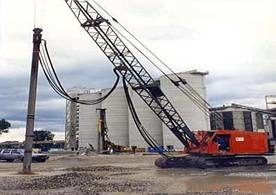
Vacuum Consolidation
Vacuum Consolidation is an effective means for improvement of saturated soft soils. The soil site is covered with an airtight membrane and vacuum is created underneath it by using dual venture and vacuum pump. The technology can provide an equivalent pre-loading of about 4.5m high conventional surcharge fill. Vacuum-assisted consolidation preloads the soil by reducing the pore pressure while maintaining a constant total stress.
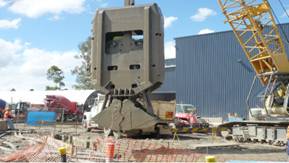
• Replace standard pre - loading techniques eliminating the risk of failure.
• Combine with a water pre-loading in scare fill area. The method is used to build large developments on thick compressible soil.
• Combine with embankment pre-load using the increased stability Preloading
Preloading has been used for many years without change in the method or application to improve soil properties. Preloading or pre-compression is the process of placing additional vertical stress on a compressible soil to remove pore water over time. The pore water dissipation reduces the total volume causing settlement. Surcharging is an economical method for ground improvement. However, the consolidation of the soils is time dependent, delaying construction projects making it a non-feasible alternative.
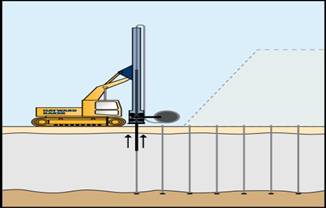
The soils treated are Organic silt, Varved silts and clays, soft clay, Dredged material The design considerations which should be made are bearing capacity, Slope stability, Degree of consolidation.
Ground Freezing
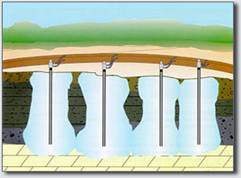
Ground freezing is the use of refrigeration to convert in-situ pore water to ice. The ice then acts as a cement or glue, bonding together adjacent particles of soil or blocks of rock to increase their combined strength and make them impervious. The ground freezing considerations are Thermal analysis , Refrigeration system geometry , Thermal properties of soil and rock , freezing rates, Energy requirements, Coolant/ refrigerant distribution system analysis.
VIBRO-REPLACEMENT STONE COLUMNS:
Vibro-Replacement extends the range of soils that can be improved by vibratory techniques to include cohesive soils. Reinforcement of the soil with compacted granular columns or “stone columns” is accomplished by the top-feed method. The important Vibro-replacement stone columns are Ground conditions, Relative density, Degree of saturation, Permeation.
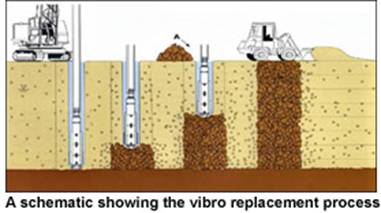
2.6.1. PRINCIPLES OF VIBRO-REPLACEMENT:
The stone columns and intervening soil form and integrated foundation support system having low compressibility and improved load bearing capacity. In cohesive soils, excess pore water pressure is readily dissipated by the stone columns and for this reason, reduced settlements occur at a faster rate than is normally the case with cohesive soils.
There are different types of installation methods which can be broadly classified in the following manner:
• Wet top feed method
• Dry bottom feed method
• Offshore bottom feed method
CONCLUSION:
Though the term Ground Improvement has been familiar to Civil Engineers, the design approach is still empirical, mostly based on past experience. Application of Ground Improvement is not only cheaper but reduce the construction time significantly. Hence a conscious effort to prepare and follow up the techniques will lead to successful completion of the project, we are now technically sound at hand. In this paper, aspects such as methods of ground improvement techniques, its applications and design considerations etc. have been discussed. The ground improvement technique also plays a vital role in the development of our mother land by 2020.